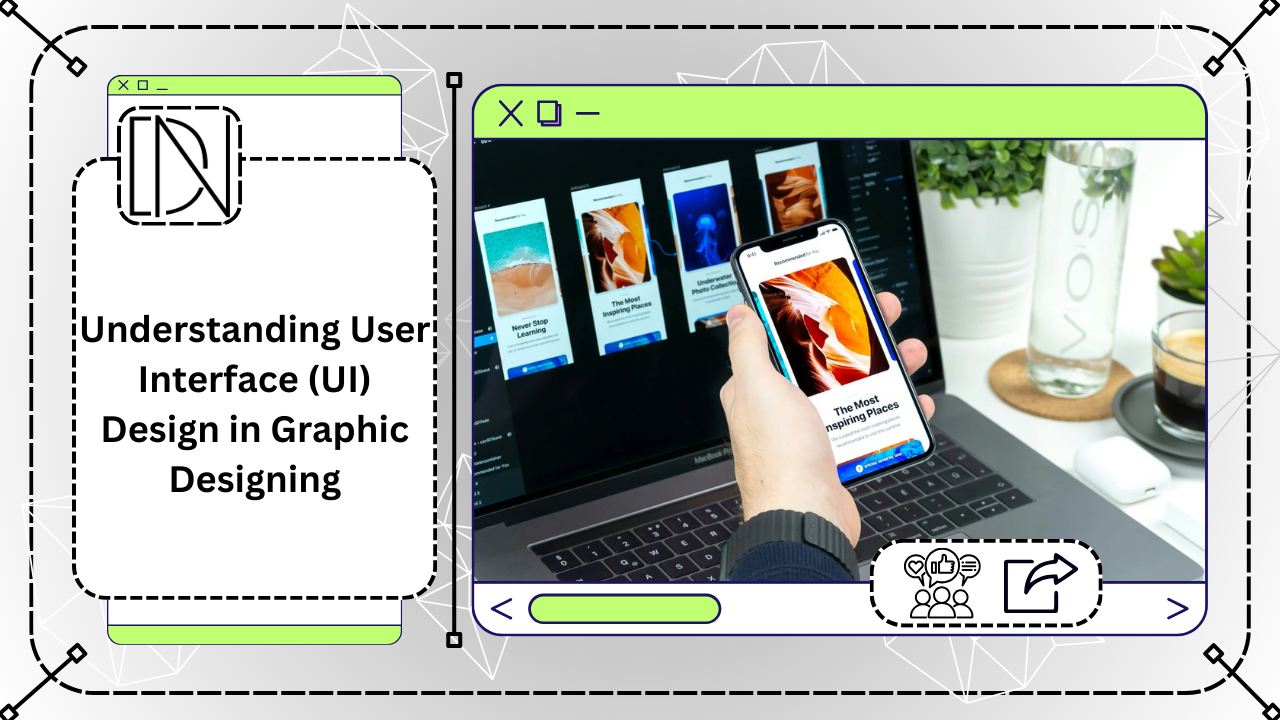When it comes to graphic designing, one of the most important aspects to consider is User Interface (UI) design. UI design plays a crucial role in creating visually appealing and user-friendly interfaces for websites, applications, and other digital platforms. In this blog post, we will delve into the world of UI design, exploring its significance, principles, and best practices.
What is User Interface (UI) Design?
User Interface (UI) design is a crucial aspect of creating digital products that are not only functional but also engaging. At its core, UI design focuses on the look and feel of a product, mainly emphasizing aesthetics, layout, and interaction elements. A well-executed UI enhances the overall user experience, ensuring that users can easily navigate and interact with a website or application.
User Interface (UI) design refers to the process of creating interfaces that users interact with on digital platforms. It involves designing the visual elements, layout, and overall aesthetics of a user interface to ensure a seamless and intuitive user experience. UI designers work closely with UX (User Experience) designers to create interfaces that are not only visually appealing but also functional and easy to navigate.
The Importance of UI Design
Good UI design is vital for retaining users and encouraging them to engage with your content. When users find a product appealing and easy to navigate, they are more likely to return and recommend it to others. Effective UI design involves understanding user behavior and preferences, allowing designers to craft interfaces that resonate with users. A seamless UI can lead to increased customer satisfaction and loyalty, making it essential for any business aiming for success in the digital landscape.
Key Principles of UI Design
Several principles guide UI design, ensuring that interfaces are intuitive and user-friendly. First, consistency in design elements helps users quickly understand how to interact with a product. Second, feedback mechanisms, such as visual cues and prompts, provide users with clarity on their actions. Lastly, accessibility is paramount; a well-designed UI should be usable by individuals of all abilities, making sure everyone can enjoy a seamless experience.
In summary, understanding User Interface (UI) design is essential for creating products that not only look great but provide users with an enjoyable experience. By prioritizing good UI principles, designers can build engaging interfaces that keep users coming back for more.
The Significance of UI Design
The Role of UI Design
User Interface (UI) design is a crucial component of any digital product. It represents how users interact and engage with applications, websites, and platforms. A well-crafted UI design enhances user experience, making it not only visually appealing but also functional and accessible. As we navigate an increasingly digital world, the significance of UI design cannot be overstated.
Why Good UI Design Matters
Good UI design directly impacts user satisfaction and retention. When an interface is intuitive and easy to navigate, users are more likely to enjoy their experience, leading to positive interactions. Furthermore, significant UI considerations such as color choice, typography, and layout affect how users perceive a brand and can significantly influence conversion rates. Prioritizing effective UI design can thus be a game-changer for businesses.
UI Design and User Engagement
In terms of user engagement, the significance of UI design is evident. Effective design guides users through tasks seamlessly, minimizing frustration and confusion. This not only improves productivity but also fosters a positive emotional response, encouraging users to return. Investing in thoughtful UI design means investing in a smoother journey for users, ultimately driving up client loyalty and satisfaction. In conclusion, the significance of UI design plays a pivotal role in the success of digital products, and its impact should never be underestimated.
UI design plays a crucial role in enhancing the overall user experience. A well-designed user interface can make a significant difference in how users interact with a website or application. Here are some key reasons why UI design is important:
Visual Appeal: A visually appealing interface can captivate users and make a strong first impression. It helps in creating a positive brand image and increasing user engagement.
Usability: A well-designed UI ensures that users can easily navigate through the interface and perform desired actions without confusion or frustration.
Consistency: Consistency in UI design helps users in understanding and predicting the behavior of different elements across the interface, leading to a smoother user experience.
Accessibility: UI design should also take into account accessibility considerations, ensuring that the interface is usable for users with disabilities.
Principles of UI Design
The Importance of Consistency
One of the foundational principles of UI design is consistency. Consistency ensures that users can easily navigate through an interface without confusion. This includes consistent use of colors, fonts, and icons, allowing users to build a mental model of how the application or website operates. By maintaining a cohesive design language, users can better understand and anticipate the behaviors of different elements.
Accessibility and Usability
Another essential principle is accessibility, which emphasizes the need for designs to be usable by all individuals, regardless of their abilities. An accessible design takes into consideration various user needs, providing alternate text for images, ensuring proper color contrast, and utilizing keyboard navigation. By prioritizing these aspects, designers create a more inclusive experience, catering to a wider audience and boosting overall user satisfaction.
Visual Hierarchy and Feedback
A well-structured visual hierarchy is vital in guiding users through an interface. This can be achieved by using size, color, and spacing to highlight important elements. Moreover, providing feedback for user interactions reinforces understanding and improves engagement. Simple visual cues, such as changing a button’s color when hovered over, can clarify actions and enhance the overall usability of a product.
In summary, by integrating these principles of UI design, creators can craft user-friendly interfaces that deliver both functionality and aesthetics, ultimately leading to a better user experience.
UI design follows certain principles that guide designers in creating effective interfaces. While there are several principles, here are some of the key ones:
- Simplicity: Keeping the interface simple and uncluttered is essential for a good user experience. Avoid overwhelming users with too many elements or complex layouts.
- Consistency: Consistency in design helps users in understanding and navigating the interface. Use consistent colors, typography, and layout throughout the interface.
- Hierarchy: Establish a clear visual hierarchy to guide users’ attention and prioritize important elements. Use size, color, and placement to indicate the importance of different elements.
- Feedback: Provide visual feedback to users when they interact with elements. This helps in confirming their actions and provides a sense of control.
- Navigation: Design intuitive and easy-to-use navigation menus and buttons to ensure users can move through the interface effortlessly.
Best Practices for UI Design
User Interface (UI) Design plays a crucial role in creating a positive experience for users interacting with digital products. Effective UI design blends aesthetics with functionality, making it essential for designers to adhere to best practices that enhance usability and engagement.
1. Emphasize Simplicity
One of the foremost best practices for UI design is to prioritize simplicity. A cluttered interface can overwhelm users and deter them from completing desired actions. Aim for a clean design by minimizing elements and ensuring that each component serves a purpose. This not only improves aesthetics but also makes navigation intuitive, allowing users to find what they need effortlessly.
2. Consistency is Key
Consistency across your UI elements help users build familiarity and trust with your interface. Use the same style for buttons, colors, and typography throughout your design. This cohesive look not only enhances the appeal but also guides users smoothly from one interaction to another. Remember, a consistent UI leads to a more predictable and enjoyable user experience.
3. Prioritize Accessibility
Another critical aspect of UI design best practices is ensuring that your interfaces are accessible to all users, including those with disabilities. Consider using high-contrast colors for readability, providing alt text for images, and ensuring that your UI can be navigated using keyboard shortcuts. By prioritizing accessibility, you make your product inclusive and enhance the experience for everyone.
Conclusion
Incorporating these best practices for UI design will not only result in a visually appealing product but also enhance user satisfaction. By focusing on simplicity, maintaining consistency, and prioritizing accessibility, designers can create engaging and effective user interfaces that resonate with their target audience.
Here are some best practices to keep in mind while designing user interfaces:
Research: Conduct user research to understand the target audience and their needs. This will help in creating interfaces that cater to their preferences and expectations.
Wireframing: Create wireframes to plan the layout and structure of the interface before diving into the visual design. This helps in identifying potential issues and refining the design.
Color and Typography: Choose colors and typography that align with the brand identity and enhance readability. Use colors strategically to create visual interest and guide users’ attention.
Whitespace: Utilize whitespace effectively to create a balanced and uncluttered interface. Whitespace helps in improving readability and highlighting important elements.
Responsive Design: Design interfaces that are responsive and adaptable to different screen sizes and devices. This ensures a consistent user experience across various platforms.
By following these principles and best practices, UI designers can create interfaces that are not only visually appealing but also functional and user-friendly. Remember, UI design is a continuous process that requires iteration and improvement based on user feedback and evolving design trends.
In conclusion, User Interface (UI) design is a vital aspect of graphic designing. It focuses on creating visually appealing and user-friendly interfaces for digital platforms. By understanding the significance, principles, and best practices of UI design, designers can create interfaces that enhance the overall user experience and drive engagement.












